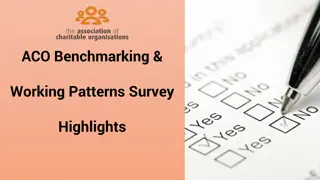Impact and Evaluation Toolkit for Churches and Christian Charities
This toolkit aims to equip churches and Christian charities engaged in small-scale social action projects to think about impact, measure impact, choose data tools, reflect on evaluation data, and use it effectively. It covers principles of evaluation, setting objectives, selecting indicators, storytelling, and utilizing evaluation data well. Key terms related to evaluation are defined, emphasizing the importance of monitoring and evaluation in making wise decisions for impactful investments.
Download Presentation

Please find below an Image/Link to download the presentation.
The content on the website is provided AS IS for your information and personal use only. It may not be sold, licensed, or shared on other websites without obtaining consent from the author.If you encounter any issues during the download, it is possible that the publisher has removed the file from their server.
You are allowed to download the files provided on this website for personal or commercial use, subject to the condition that they are used lawfully. All files are the property of their respective owners.
The content on the website is provided AS IS for your information and personal use only. It may not be sold, licensed, or shared on other websites without obtaining consent from the author.
E N D
Presentation Transcript
Impact and Evaluation A Toolkit
The purpose of this toolkit The purpose of this toolkit is to equip churches and Christian charities engaged in small-scale social action projects to: think about the kind of impact they want to have think about how to measure that impact choose and use quantitative and qualitative tools for gathering data reflect on and use their evaluation data effectively
Outline This toolkit contains the following sections: 1. Principles: why and how to evaluate? 2. Planning and setting objectives 3. Selecting indicators and data collection methods 4. Storytelling 5. Using your evaluation data well
Definitionof key terms Understanding evaluation terminology can help you plan your evaluation more effectively. Here are some of the key terms we use in this presentation: Objectives: the specific changes that you seek to achieve within a certain timeframe Outputs: products or services delivered by an organisation or project Impact: broad or longer-term effects of a project or organisation s work Monitoring: the routine, systematic collection and recording of data about a project Evaluation: using monitoring and other data you collect to make judgements about your project or organisation
1. Principles Why should we evaluate our projects?
1. Principles: Why should we evaluate our projects? Monitoring and Evaluation is not just for funders Stewardship is important to God As Christians, we have a responsibility to wisely invest the resources that have been entrusted to us (Mt. 25: 14-30) Good monitoring and evaluation of our social action projects help us make wiser decisions about where our investment can have greater impact
1. Principles: Why should we evaluate our projects? Learning is important to God (Prov. 1:5, Rom. 12:1) God gave us minds so that we might grow in knowledge and wisdom Evaluation helps us to acquire knowledge about what a project is doing, how well it is achieving its aims, and where it might be struggling Reflecting on this knowledge can give us wisdom about how to grow or improve a project
1. Principles: Why should we evaluate our projects? Integrity is important to God (Lev. 19:35-36, Col. 3:9) Scripture calls us to honesty in measurement and communication The questions that we ask and the ways that we report the data should be as transparent and unbiased as possible It s important to get multiple perspectives on our projects including the voices of participants, staff, and volunteers We should be careful not to exaggerate success or conceal failure
1. Principles: Why should we evaluate our projects? Respect for all persons is important to God (Gen. 1:26-27, Mt. 7:12) Undergirding our approach to monitoring and evaluation is the recognition that every individual is made in the image of God and should be treated with respect People and relationships are more important than results or efficiency Monitoring and evaluation tools and processes must respect participant privacy, time, emotional wellbeing, and relationships
1. Principles: Why should we evaluate our projects? And in all things, we remember our dependence on God Whilst we seek to plan wisely and track progress faithfully, we recognise that ultimately it is God who brings change (Ps. 127:1), and that God often does that in rather mysterious ways (Mark 4:26-29)
2. Planning and Setting objectives
2. Planning and setting objectives For evaluation to be meaningful and useful, it needs to be integrated into your project from the design stage As part of your planning, gather together those who will be involved in the management and delivery of the project to discuss the questions set out on the following slides Working through these questions as a group will help you to identify the objectives and outputs of the project This will help you to know what data you will need to collect in order to measure and understand your impact
2. Planning and setting objectives What changes do you hope to see as a result of your project? i.e. what are your objectives? God gave us minds so that we might grow in knowledge and wisdom Evaluation helps us to acquire knowledge about what a project is doing, how well it is achieving its aims, and where it might be struggling Reflecting on this knowledge can give us wisdom about how to grow or improve a project
2. Planning and setting objectives Who are you trying to reach? What changes do you hope to see in the short term (say 1-2 years from now) and in the longer-term (say 3-5 years from now)? What needs or challenges do you want to address? What assets do you seek to release and encourage? What are others in your area doing to achieve those same objectives? How will your project support or complement their work?
2. Planning and setting objectives What will you do? i.e. what are your outputs? What activities will help you reach your objectives? Do you know that there is a desire or need for this activity? Is anyone else already doing it? What is the best way to deliver this activity? What is realistic and sustainable? How can we make sure we are keeping track of these activities?
Planning Example You would like to provide more employment opportunities for young adults with learning disabilities 1. What changes do you hope to see as a result of your project? (objectives) We want to see more young adults with learning disabilities gain and sustain employment; we want those young adults to increase in self-confidence and to feel more connected to our church community 2. Who are you trying to reach? People aged 18-25 in our local parish that have learning disabilities 3. What will you do? (outputs) Within our church caf we will train, employ and support young people with disabilities to work as waiters
3. Selecting indicators and Data collection methods
3. Selecting indicators and data collection methods After you have defined the changes you want to see, you then need to think about how you will know whether you are making progress towards achieving your objectives This is the step of selectingindicators and (where appropriate) targets. An indicator is simply a piece of information that signals change. The strongest indicators are those that are measurable, specific, and reliable Indicators can be either quantitative (objective things you can count) or qualitative (subjective things like changes in attitudes or confidence) Quantitative data are captured in numbers, while qualitative data are usually captured through stories, conversations, observations, and text
3. Selecting indicators and data collection methods For each of your project objectives, ask yourselves: What information do we need to determine whether we have met that objective? Coming back to the example of the church caf employing young people with learning disabilities, our indicators would be: # of young people with learning disabilities employed in the caf The length of their employment in the caf % of young people employed in the caf that report having greater self confidence % of young people employed in the caf that report feeling more connected to the church community # of church members involved in training young people
3. Selecting indicators and data collection methods Next is the step of selecting your data collection methods, and these will depend on the type of information you want to collect, for example: Interviews: are structured conversations that enable you to gather subjective, in- depth data from individuals or small groups Focus groups: are facilitated discussions with up to 8 people that enable you to collect the information that arises from the group s interaction Surveys: are a useful way to get well-structured quantitative and qualitative data that can be collated and analysed Observation: is the process of people learning about others by observing them undertake their usual activities in their normal environment There are many resources available online to help you choose and refine your data collection methods, including at https://knowhow.ncvo.org.uk
3. Selecting indicators and data collection methods For each indicator selected, you will need to ask yourselves: How will we access and record that information? Coming back to the example of the caf : # of young people employed in the caf and # of church members involved in training (the quantitative indicators) would be captured in a spreadsheet kept up to date by project staff The qualitative indicators would be captured using short, ability-appropriate questions where the young people could report their confidence and feelings of connectedness Project staff could also record their observations of the confidence of the young people in completing tasks
3. Selecting indicators and data collection methods Coming back to the example of the caf , we can summarise in a table Objectives Indicators Data collection method 1. More young adults with learning disabilities will gain and sustain employment 1a. # of young adults with learning disabilities employed in church caf Administrative spreadsheet 1b. Length of their employment Administrative spreadsheet 2. Those young adults will increase in self-confidence 2a. % of young adults employed that report an increase in self-confidence Surveys/interviews Staff observations 2b. Staff reflections on employees confidence 3. Those young adults will feel more connected to our church community 3a. % of young adults employed that report feeling more connected to the church community Surveys/interviews 3b. # of church members involved in training young adults Administrative spreadsheet
3. Selecting indicators and data collection methods You then need to ask yourselves: How reliable is the information we have collected? Coming back to the example of the caf : Project staff/volunteers should note down numbers, observations, and notes from conversations and interactions promptly Whenever possible, the observations of one staff person/volunteer should be triangulated with the observations and perceptions of others (other staff/volunteers, participants) Developing effective surveys that collect exactly the right information is difficult and there is much guidance available online to help you, including here
4. Storytelling Stories are powerful communication tools While numbers can help us understand how much change has happened, human stories help us understand how those changes have happened and why they are significant Telling simple stories of change is a valid way to capture and communicate the impact of your project They can help people to make an emotional connection with your work as they better understand its impact on people s lives Short stories can be shared widely via social media, email and in reports to funders
4. Storytelling For a story to be effective, it should contain the following elements: The context: Where did this story happen? When did it happen? Who was involved? What were they doing? The challenge or opportunity for change: What problem or challenge were people facing? What opportunities or assets did people build on? Your project s involvement: What did your project do to address that challenge or opportunity? Did you facilitate training, deliver direct support, connect people to resources etc.? The change: As a result of your project, what changed for the people involved in this story? Why is this significant? Link this description to one or more of the aims of your project Good stories do not have to be long. Describing all of the things above can be done effectively in as few as 150 words
4. Storytelling The most powerful stories are usually those shared directly by people whose lives have been impacted by the project and who are keen to share from their own experience Enabling people to have a voice and to share their own story can itself be a very significant part of the process of change It can also be valuable to listen to the observations, experiences, and perspectives of staff, volunteers, and others in the wider community, who also have experience of your project
4. Storytelling If you want to share people s stories, there are some important ethical considerations to bear in mind: Informed consent: Before you record or share a story, you must first seek that person s permission. You need to tell them why you want to document their story and how you plan to use it. Everyone s decision about whether to share their story needs to be informed and voluntary Confidentiality: To protect people s privacy, it is usually best to anonymise their story, unless they explicitly give permission to be identified in the story. If the person is vulnerable in any way, it is particularly important to share their story in a way that cannot be linked back to them individually Data protection: In accordance with the General Data Protection Regulation (GDPR), be sure that you are storing personal data securely and only for as long as you need it (See GDPR guidelines here)
5. Using evaluation data well
5. Using evaluation data well Evaluation is not an end in itself. The purpose of collecting evaluation data is to equip you to reflect on how things are going, learn from successes and setbacks, assess progress towards your objectives, and improve the project you are running Reflecting on evaluation data is useful internally for the team running the project and also externally to share what you are learning with partners, funders, or other audiences At the outset of the project it is helpful to think about: Frequency: How often will you pause to look at and reflect on the data you are collecting? Audiences: With whom do you want to share the data, and for what purposes?
5. Using evaluation data well Frequency of assessment depends on the scale and type of your project Larger, more complex projects require more frequent assessment, while smaller scale and less complex projects require less frequent assessment Given that community-level projects tend to operate on a termly schedule, a good starting point could be to carve out time to reflect at the end of each term, and then have a more in-depth reflection once a year
5. Using evaluation data well Some of the audiences you might want to feed back to are: project delivery team; church leadership; funders; external audiences e.g. local government; project participants For each of these audiences, think about what kind of information is most helpful for them to have and what format will be most accessible and effective, for example: For a delivery team, a facilitated discussion might be the best format in which to learn from evaluation data For a funder, a written report that clearly describes progress against agreed outcomes may be the best format For external audiences, sharing an individual case study at an event or via social media could be most effective in sharing what your project is achieving or learning
5. Using evaluation data well Whatever you decide around frequency of reflection and audiences, the key questions you want to ask when you have your evaluation data in front of you are: What has gone well and why? What has not gone well and why? Are you on track to meet your objectives for the year? What key changes have you observed for participants and/or the wider community through your project? What is one change the project team could make to improve delivery next quarter/term/year? What learning can you share with others?
Other resources There is a wealth of tools and guidance available online to help you plan, monitor and evaluate your project effectively. Here are some examples: NPC s resources on impact measurement, evaluation and data can be found here https://www.thinknpc.org/themes/measure-and-manage-impact/impact-measurement- evaluation-and-data/ You can find out more the theory of change approach here Theory of Change | NCVO Additional tools available from CUF at: Project Evaluation Tools CUF Do get in touch at lindsey.Donoghue@cuf.org.uk for specific guidance.























